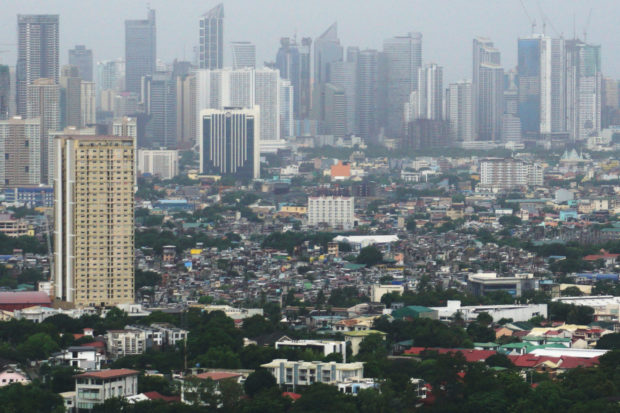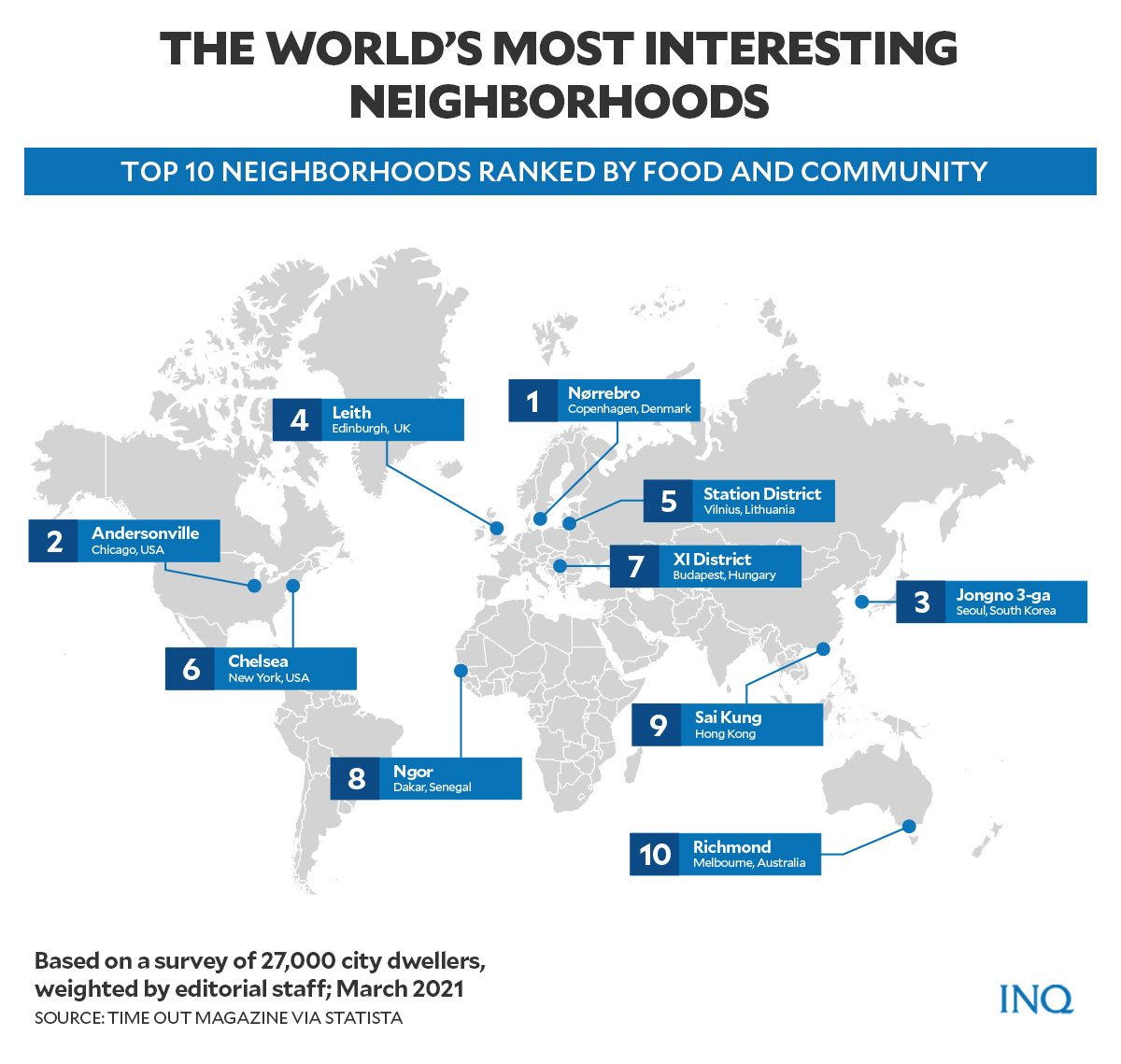In time of pandemic, Makati’s Poblacion makes it to world’s most interesting list
MANILA, Philippines—Poblacion, a hub of dining and culture and arguably one of the hippest areas in Metro Manila, has been named among the 49 coolest neighborhoods in the world by Time Out Magazine.
For over a year now, the COVID-19 pandemic has put a halt to the movement of people across the globe. The usual nightlife, dine-ins, and cultural events have been pushed back to prioritize everyone’s health and safety against the dreaded disease.
However, as some countries loosen border restrictions, restaurants, cafes, and bars are reopening and welcoming eager individuals.
This has inspired Time Out magazine — a global magazine focused on travel guides, including the best art and entertainment, food and drink, attractions, and things to do in cities around the world — to come up with this year’s ranking of the world’s coolest neighborhoods.
“This year, we couldn’t help but switch up our priorities,” said Huw Oliver, editor of Time Out’s international team.
“Food, drink, nightlife, culture – important. Community spirit, resilience, sustainability – just as important, especially if we are to come out of this pandemic with things we can be proud of and tell the rest of the world about,” he added.
A ‘treasure trove’
Poblacion in Makati City, located near Makati’s Central Business District, ranked 46th out of the 49 neighborhoods listed by the international travel and culture magazine.
Surrounded by hole-in-the-wall restaurants, the neighborhood was chosen for its gastronomy, culture, and fun and interesting activities.
READ: Discovering Poblacion through history and food
“Once best known for its red-light district, the area today brims with old apartments-turned-businesses and hostels that draw an eclectic mix of locals and visitors from the 15 other districts that make up Manila,” wrote local food and travel writer Shirin Bhandari, who is also a contributing journalist for Time Out.
“The pandemic has made most indoor dining a no-go even now, but an array of outdoor galleries, rooftop bars, and open-air art spaces mean it’s still pretty easy to have fun here,” she added.
Bhandari highlighted Poblacion’s go-to places such as the Agimat Foraging and Kitchen Bar — a bar and kitchen located in a traditional two-story bahay na bato-styled establishment — and Alamat — a Filipino pub and deli which serves craft beers and cocktails alongside crowd-favorite pulutans (Filipino tapas) such as skewers.
Both establishments, according to Bhandari, have survived during the pandemic, unlike some institutions that have been forced to shut down amid restrictions and lockdowns.
She also recommended trying goto, a rice porridge prepared and cooked with innards, tripe, and beef or pork.
“It may sound daunting, but is just the thing if you’ve had a heavy night the day before,” she said.
For those who are planning to go for a walk in the area, Bhandari recommended the Makati Poblacion Park and exploring Makati Museum as well as the 399-year-old Saints Peter and Paul church.
Travelers might also someday try to get a glimpse of the Bailes Delos Arcos (Dancers of the Arch) held every 29th of June.
“A festival that involves dancers from select families in Barangay Poblacion jiving in honour of the area’s patron saints,” Bhandari wrote.
In the spotlight
The carefully crafted drinks and traditional food and tapas of the bars in Poblacion were just among the several Filipino dishes that were highlighted and given recognition overseas this year.
Two months ago, TasteAtlas – an online encyclopedia and world atlas of traditional dishes, local ingredients, and authentic restaurants – hailed the Philippines’ sinigang as the best vegetable soup in the world.
Sinigang, known for its sour yet balanced broth that complements the harsh tropical heat in the country, received 4.8 out of 5 stars and finished first in the tier list.
“With its sour lightness perfectly matching the harsh tropical heat of the country, sinigang is a unique soup that is a true representative of Filipino cuisine,” TasteAtlas said.
READ: Sinigang hailed top vegetable soup in the world on TasteAtlas
A month earlier, adobo — one of the most popular dishes in the country — has stirred conversation among many Filipinos as the Department of Trade and Industry (DTI) announced that it will set national standards for cooking adobo.
In July, the Bureau of Philippine Standards (BPS), an agency under the DTI, said it has formed a committee that would create a national standard for native Filipino viands, the first of which is adobo.
The process will take into consideration the different ways to cook the dish across the country, the bureau said.
The announcement, however, was met with backlash. While some prodded DTI to leave adobo alone, some argued it was not the best time to include it in the government’s agenda — especially amid the ongoing COVID-19 pandemic.
READ: Gastrodiplomacy: How they’re promoting Filipino food abroad
DTI later clarified that the agency will not tinker with the local standards in cooking adobo and other Filipino dishes that the countries would like to promote abroad.
Trade Secretary Ramon Lopez likewise explained that the move was meant to protect the Philippine adobo from other countries which might lay claim to the pioneering adobo.
“You know, abroad, there will be people who will say there’s Mexican Adobo. There are many versions of adobo,” he said.
“We just don’t want others to claim our Philippine adobo, so we need to promote a basic traditional recipe. Other countries are also doing that, they formulate their own traditional recipe,” he added.
READ: DTI says standardizing Philippine adobo only for international promotion
Another dish that has become a controversial topic among many this year was lugaw — a popular and affordable rice porridge made from cooked glutinous rice and flavored with fermented fish sauce (patis) or just plain salt.
In March, while some areas in the country were placed under enhanced community quarantine (ECQ), a video showing a female barangay official in Bulacan barring a delivery rider from picking up an order of lugaw supposedly due to curfew hours went viral online.
Discussions on whether lugaw is essential food were all around the internet and has prompted an official statement from the country’s seat of power – Malacañang, which even had to clarify that lugaw is an essential good since it is food and that all food deliveries are allowed and must not be stopped despite the implementation of enhanced community quarantine in the NCR Plus bubble (Metro Manila, Rizal, Cavite, Laguna, and Bulacan).
The National Commission for Culture and the Arts (NCCA) and the National Quincentennial Committee (NQC) likewise said the dish is essential — as it is a symbol of the Philippines’ rich culture and “one of the earliest documented food of our ancestors.”
READ: Lugaw: An essential in all its many forms
‘Unusual picks’
The list curated by Time Out magazine was based on the results of a survey, which had 27,000 city dwellers as respondents.
According to Time Out, the magazine’s local editors and contributors “vetted the public vote against those all-important criteria – cool stuff, but also kind stuff, forward-looking stuff – and made their final picks.”
The selections were then ranked by a panel of experts.
Among the top ten coolest neighborhoods in the world, according to the magazine, were:
- Nørrebro in Copenhagen, Denmark
- Andersonville in Chicago, USA.
- Jongno 3-ga in Seoul, Korea
- Leith in Edinburgh, Scotland.
- Station District in Vilnius, Lithuania.
- Chelsea in New York, USA.
- XI District in Budapest
- Ngor in Dakar, Senegal.
- Sai Kung in Hong Kong.
- Richmond in Melbourne, Australia
For Florian Zandt, data journalist of data consumer company Statista, the list included some “unusual picks.”
“While the survey among 27,000 city dwellers identified mainstays like New York and its Chelsea neighborhood, the lively XI District of Budapest or the historical Jongno 3-ga area of Seoul as some of the boroughs that offer city trippers a lot in terms of culinary richness, culture and a sense of community, the Senegalese capital Dakar and its Ngor quarter and Vilnius’ Station District are more unusual picks,” Zandt wrote.
“This might be rooted in the methodology of the survey, with local editors weighing the results according to their expertise and more importance given to the communality aspect brought to the forefront by the global pandemic,” he added.

